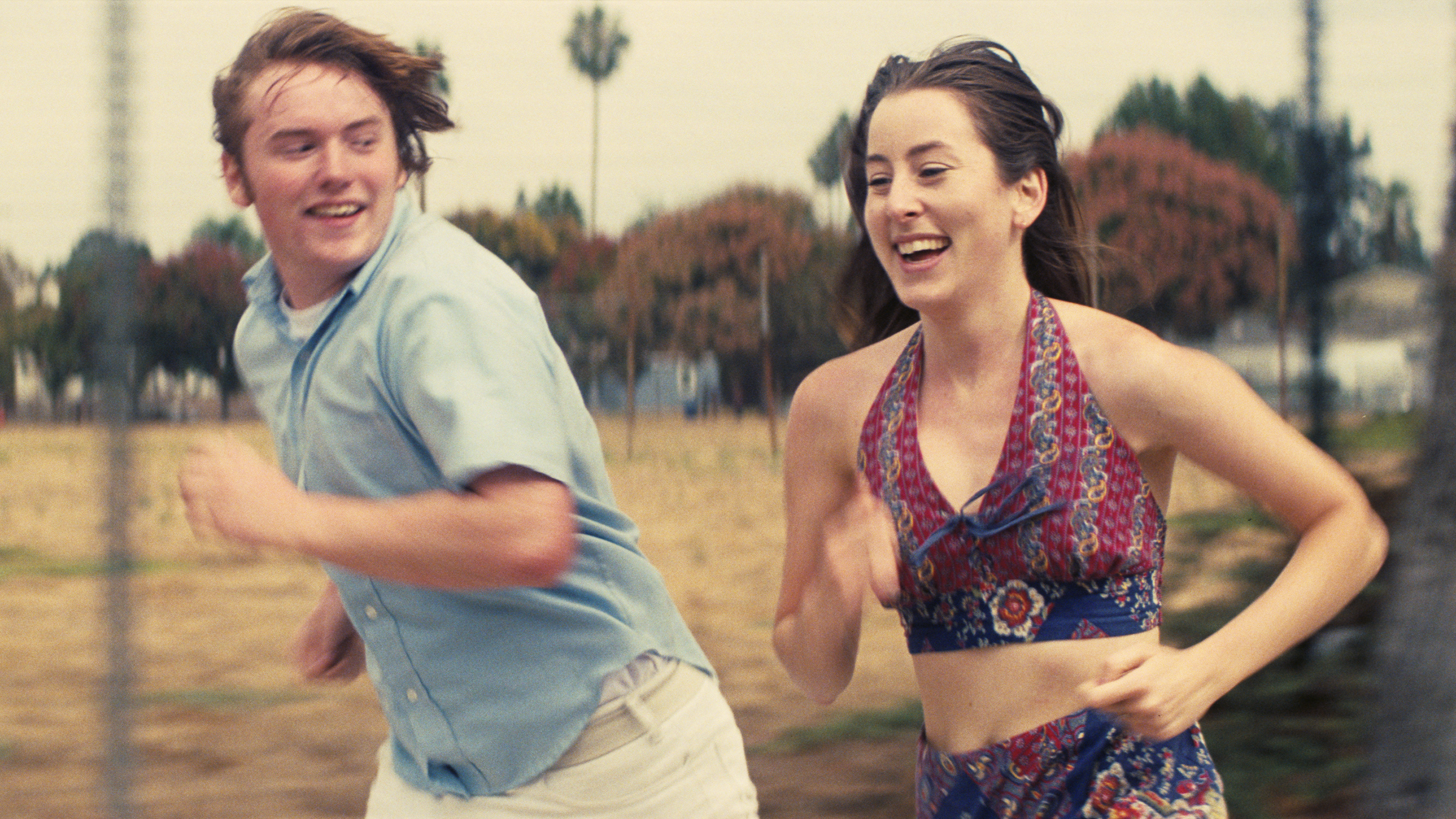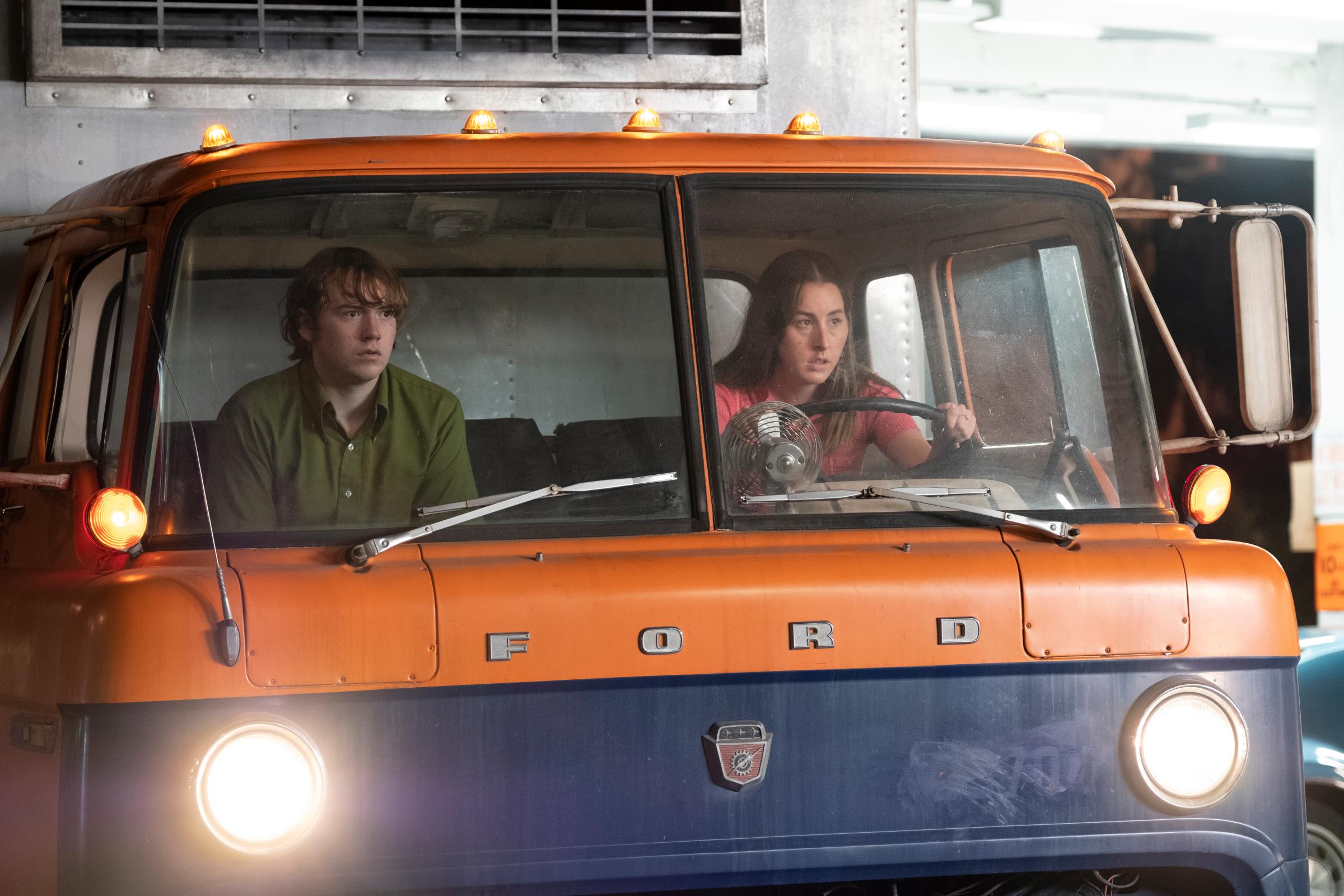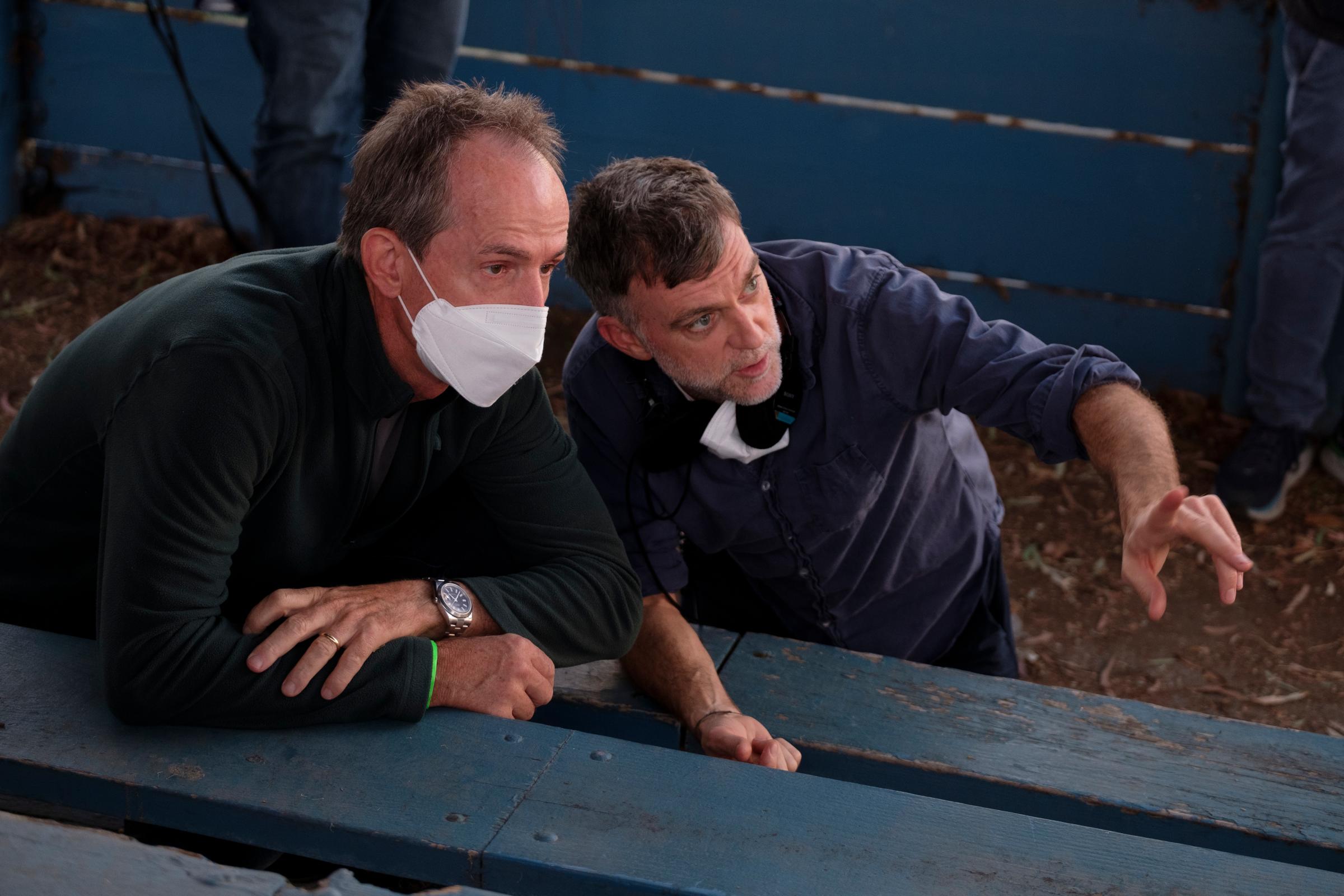Licorice Pizza, the new movie from writer-director Paul Thomas Anderson (There Will Be Blood, Phantom Thread), is a shaggy love story set in California’s San Fernando Valley in 1973. The protagonists are 15-year-old Gary Valentine (Cooper Hoffman, son of the late Philip Seymour Hoffman, a frequent Anderson collaborator) and the aimless, slightly older Alana Kane (Alana Haim of the rock sister-trio Haim). “Ever since I was a kid, I’ve been a song-and-dance man,” a precocious Gary tells Alana before igniting a series of schemes—having her chaperone him on the press tour for a movie he appears in, starting a waterbed company, opening a pinball store—meant to win her heart.
Anderson had directed several music videos for the group Haim before he cast its youngest member, who steals Licorice Pizza from seasoned Hollywood vets like Bradley Cooper, Sean Penn and Tom Waits. TIME sat down with Anderson and Haim in New York City to talk about the film, due in theaters Nov. 26; their creative partnership; and learning to drive a massive manual U-Haul named Gertrude through the streets of Los Angeles.

TIME: Paul, you first met the Haim sisters because you liked their music videos, right?
Anderson: I liked their music first, because I heard it on the radio. It was “Forever.” It’s still one of my favorite songs. It nagged at me that there was something deeper beyond just liking their music, and it revealed itself that their mother was my favorite teacher I’d ever had, when I was 7 years old.
Haim: Miss Rose, the most amazing art-teacher name.
Anderson: I went to a school that was very strict gray-haired ladies. This was an art teacher who looks exactly like Alana.
Haim: I’m a spitting image.
Anderson: With long, beautiful hair, who would play guitar and teach us how to paint, burned into my memory as this rainbow. So I was thrilled to make this connection, not just to them but back to their mom.
How did that transition into a more creative partnership?
Haim: Very organically. We were in the middle of recording our second album, Something to Tell You. We were in the studio and we said, “Why don’t we show Paul what we have?” He saw the instruments being set up and came to the conclusion, “Why don’t we just film this?” It’s really hard to capture magic with a live-music component. Growing up, I always envied Tom Petty at Sound City because there’s all this footage of Tom Petty where he just plugs in his guitar and everyone’s looking at each other and it’s the most amazing thing ever. When Paul had suggested to do what became “Valentine,” it turned out to be the most beautiful, incredible depiction of me and my sisters. It was the first time we had seen ourselves and said, “That’s how we always wanted to be depicted.” After that, it’s kind of hard to go to anybody else. Every time we needed a music video: “We gotta call Paul.”
Anderson: Oftentimes, when you’re filming live music, something gets disconnected. There are too many cuts or the music ends up not feeling live or something just feels processed about it. I want to see you play. The more we just film you in the process of creating these songs, the less we have to do, actually. If there’s a slight bum note, you have to live with it. If anything, it adds to the authenticity. You have to leave your ego behind a little bit.
Did you have a history of inviting people into the studio before Paul?
Haim: No. But Paul has the most music knowledge I’ve ever met in a person, and I trust his opinion more than anything. [For the] “Summer Girl” video, I have a very vivid memory of Paul in a wheelbarrow with a camera. I didn’t tell my label or anyone. We got the money that we could scrounge ourselves and went to a thrift store, bought as many layers as we could, started ripping them off on the street. It felt that way on the movie, too. There were so many moments that were so spontaneous.
Of the three sisters, what made you decide that Alana was the one you wanted to revolve this film around?
Anderson: Well, Danielle was too old. [Laughs.] I had an instinct that Alana could act. I’d seen her perform in the music videos, but that wasn’t even the biggest thing. The biggest thing was knowing her personally. She can get a little rabid, a little frothy at the mouth.
Haim: I’m a Sagittarius.
Anderson: The dynamics of this story seemed to really suit her personality. She has a “Where and when?” attitude.
That is essential for this film, because Alana had to spend a good chunk of time driving a massive U-Haul through narrow Los Angeles streets. Did you do your own stunt driving?
Haim: I did a lot.
Anderson: Eighty percent.
Haim: That was the only part of the script where I was like, “Huh. O.K., I’ll probably not do that part. This is the movies, guys.” Then Paul said, “No, you’re going to drive the truck.” I named her Gertrude. Me and Gertie, we got through it together. It really was a huge part of me becoming Alana Kane, because she is fearless. I have a vivid memory of putting her in reverse for the first time, like, “Ahhhhhh! Hard-core!” That’s when I really felt like I became her.

Anderson: The truck is talked about as such a fantastic sequence. But beyond that, it was: “You’re also going to be running through the streets in a bikini, also on the back of a motorcycle with Sean Penn, you’re going to wipe out, you’re also going to run through the streets knocking people over on your way to get Gary, you’re also going to get into ferocious fights.” There are many, many things that you’re asking an actor to attack, vulnerable situations that they’re putting themselves in over and over again.
Alana, did you have any apprehensions about what you had to do?
Anderson: She’s not like that.
Haim: That was the adventure of making this movie. Every day I was doing something completely different that I had never done before. “Now you’re a politician. Now you’re a waterbed salesman.” I loved it.
Anderson: It’s very rare to have an actor be able to shed their vanity. That’s hard for anyone, but try it with a movie camera on. Try being a woman. You want to be attractive, you want to be likable. But Alana does have a switch that, if it’s needed, will drop her vanity, be unfearful of looking out of control, vulnerable. That’s an incredibly attractive quality in an actor.

Your previous movies have been star-driven: Daniel Day-Lewis, Joaquin Phoenix, Adam Sandler. What can you accomplish by casting two novices that you can’t with A-listers?
Anderson: You can accomplish a version of time travel, because an audience isn’t bringing any baggage. They’re looking at two human beings saying words that look like they just came out of their head. I think there’s joy in discovery for an audience. I wonder what it was like to walk into a club of 50 people and see U2 when they were 19 years old. I hope audiences can feel that way looking at the two of them, like, “Who the hell are these people, and why are they on my huge movie screen?” They also look like real people. Alana’s face is the greatest thing you could hope for in a movie star. From one angle, she’s stunningly gorgeous; turn it an inch to the right, you’re like, “What’s going on with her face?” And then another turn and she looks angry, and then she looks vulnerable and confused. That’s a magic recipe.
The movie is sprinkled with references. How did you select the ones we see in the film: waterbeds, the legalization of pinball, the oil crisis, Joel Wachs, Jon Peters, Lucille Ball?
Anderson: In some ways, oddly, you try to write away from them. This story comes from real-life episodes that happened to my friend Gary Goetzman. He was a child actor—check, that’s a terrific story. He needed to get to The Ed Sullivan Show and didn’t have a chaperone, so he got a burlesque dancer to take him there—that’s fantastic. He started a waterbed company—that’s fantastic. He started a pinball store—that’s fantastic. [But] if a film becomes too preoccupied with bizarro culture details specific to a time, it can tip the weight too far in a direction it can’t hold. A waterbed is funny for a minute, but what’s important are the kids selling the waterbeds and how the waterbed business goes bust because of a gas crisis, which puts them in a larger scope of the world. They’re at the mercy of an Arab-Israeli war that has nothing to do with them but has found its way to the Valley.
Were any of those elements particularly intriguing to you, Alana?
Haim: I had never been on a waterbed before, let me tell you that. We had waterbed school.
Meaning?
Haim: Meaning we were starting a waterbed company and you can’t start a waterbed company without knowing how to put together a waterbed, with a headboard and the vinyl. You have to know what kind of seam works for the Arabian vinyl.
Anderson: Years of working with Daniel Day-Lewis has taught me a few things. I said to them, essentially, “If you guys don’t figure out how to make a waterbed, then you’re going to be pretending, so figure out how to put these waterbeds together.”
Daniel’s Method ways have infiltrated you.
Haim: We got it together in eight minutes flat.
I have to ask about Bradley Cooper, who is such a dynamo in this movie. There was a rumor at one point that Leonardo DiCaprio was going to play that role.

Anderson: I never talked to Leo. I had known Bradley a bit and had been anxious to work with him, but I didn’t create the scenario thinking it was a way to work with Bradley Cooper. The scenario was created from fact. Gary and his buddies delivered a waterbed for Jon Peters, who had a reputation for being a larger-than-life, outsized Hollywood movie producer. The story goes that nothing dramatic happened at all. He was the nicest guy in the whole world.
That’s not a good movie scene.
Anderson: Right, having Bradley Cooper turn up and say, “Thanks, guys, go on inside” is boring. So I created this batsh-t-crazy idea.
Alana, were you prepared for the gonzo ferocity that he was going to bring to those scenes?
Haim: No, there’s no preparation for that. He came out like a bat out of hell. It was so much energy, and also on top of everything, it’s like, “Oh my god, that’s Bradley Cooper! Wait, no, we’re shooting a movie, calm down.”
Anderson: The second day, Bradley and I had gotten together and mapped out ways that we were going to improvise, but we didn’t let Alana or Cooper know exactly what was going to happen. We just knew that you have a situation where you have a point A and a point B. The point A is “I picked up a gas can, and you’re going to take me to the gas station.” We created a route that was about two miles long through the winding hills of Tarazana, attached a camera and lights, and said, “Okay, go ahead.”
That entire sequence is improvised?
Haim: Yes. Paul was giggling. You have to remember it was day two and I had never acted before. I’m driving the truck and I’m trying not to kill anybody, trying not to break a camera, going through the Hills. Jon Peters is asking me, “How old are you?” I go, “28,” because I was 28 at the time. I couldn’t think of another thing to say. Then he said, “What’s your sign?” I said, “I’m a Sagittarius,” then I thought, “Oh no, I’m actually a Sagittarius.” I could have said anything! I was so nervous that I couldn’t think too quickly on my feet. Everything I said in that scene was improvised, but I could only come up with the truth.
Anderson: But there’s no other right answer.
It’s so interesting that that was improvised because you quickly correct yourself and say you’re 25. That left me wondering if she’d been lying about her age the whole time, which is a great little character detail.
Anderson: Absolutely, and that’s a very important point. I love that she caught herself because there were endless conversations about “how old is she exactly?” before we started. I liked the idea that emerged on day two, in that improv, of, “You are 28 and you’re lying about your age. You’re already at this place where you’re nervous about hanging out with these 15-year-old kids, so that’s another great reason to lie.”
So she’s really 28?
Anderson: I think she is.
Haim: I kind of like to keep people guessing.
Anderson: What’s important is that she’s so full of sh-t.
Matthew Jacobs is a New York City-based culture writer specializing in movies and television. His work has appeared in Vulture, The Cut, Vanity Fair, The Hollywood Reporter, The Wall Street Journal Magazine and HuffPost.
More Must-Reads from TIME
- Inside Elon Musk’s War on Washington
- Meet the 2025 Women of the Year
- The Harsh Truth About Disability Inclusion
- Why Do More Young Adults Have Cancer?
- Colman Domingo Leads With Radical Love
- How to Get Better at Doing Things Alone
- Cecily Strong on Goober the Clown
- Column: The Rise of America’s Broligarchy
Contact us at letters@time.com



